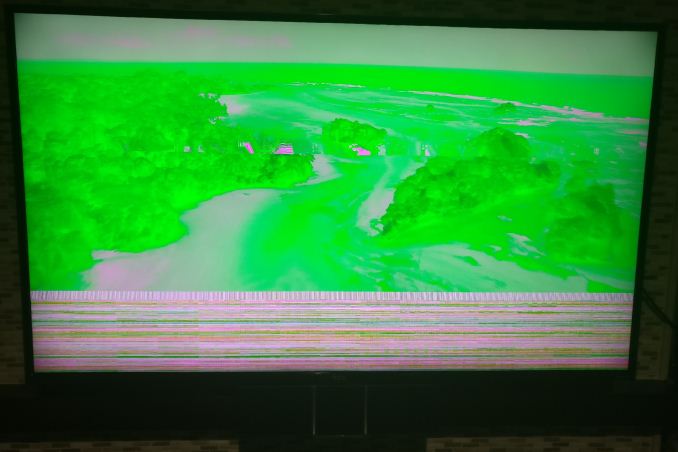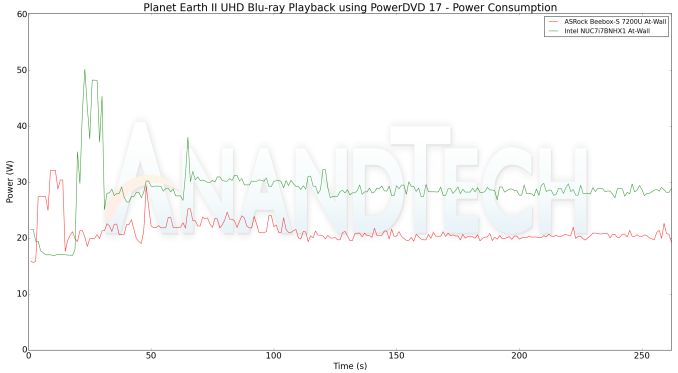A Budget Home Theater & PC Setup: 4K, HDR, UHD Blu-ray, and More
by Ganesh T S on December 26, 2017 8:30 AM ESTUHD Blu-ray Playback in Action
Prior to testing out HDR UHD Blu-ray playback using the TCL 55P607 and the Denon AVR X3400H, we did a trial run with the LG 43UD79-B monitor. The playback was flawless in SDR mode. Emboldened by these results, we moved the hardware to the home theater setup. At that time, the Windows 10 Fall Creators Update was yet to be released. Intel and CyberLink had adopted their own scheme to activate HDR in full screen mode while playing back HDR-enabled titles. Unfortunately, the TCL 55P607 (on firmware version 7.7.0 at that time) did not really like the mode switch.
Corrupted HDR Display with TCL 55P607 Firmware v7.7
I reached out to both Intel and TCL with the above results. While the latter simply washed their hands off the issue, Intel was very responsive. They went to the extent of even sourcing the same display to check at their end. Around the same time, TCL released a firmware update (v8.0.0 4127-30) that resolved the problem.
By the time I was able to upgrade my TV, Windows 10 Fall Creators Update had released and Intel's 4877 driver had also become public. My next testing round had interesting results. The 4877 driver had flawless desktop and streaming HDR, but, playing back the Planet Earth II title resulted in a BSOD, or a PowerDVD crash, or a message indicating that PowerDVD was denied access to the graphics hardware. With an older driver version (4771), I was able to play back the Blu-ray with HDR, but, had no desktop or streaming HDR.
On checking with Intel again, it became evident that the issue was specific to the Planet Earth II title. They provided me with early access to a driver slated for release in January 2018. This driver enabled both the Intel NUC7i7BNHX and the ASRock Beebox-S 7200U to successfully play back the Planet Earth II Blu-ray with HDR, while also performing as per specifications in our other tests detailed in the previous sections.
Note that the Pioneer BDR-211UBK comes with an OEM version of PowerDVD 14 that does support 4K UHD Blu-ray playback.
We tracked the power consumption of the set (PC + Blu-ray drive with the SATA-USB bridge) while playing the first chapter of the first disc in the Blu-ray set (after a full menu loop).
We find that the Beebox-S 7200U is more power efficient for this particular task. The NUC7i7BNHX is much more versatile with its Thunderbolt 3 ports, Optane support, and other bells and whistles. Can those make a difference in a generic HTPC setup? We will address that in our concluding section.













191 Comments
View All Comments
mikato - Thursday, January 18, 2018 - link
Great point, and I also agree... unless you want local storage for media content. Sure I guess the response would be to have a PC (when we had been leaving out the PC) or a NAS feed content with DLNA or whatever that is with Plex or Kodi over the network. But then you have quite a bit more than just whatever box or stick. And if you wanted to bring your content with you to a friend’s house, you couldn’t do that, when you might be able to pretty easily with one of the UCFF PCs with a disk in it. Plus I’ll add that would be able to play anything, when for instance you might not be able to play YouTube with your Amazon stick or play Amazon with your Google stick.We’re close, but not quite there yet. What is there does cover things enough for a lot of people though.
Duto - Friday, December 29, 2017 - link
A TCL TV set?, really? , unbelievable!rapster - Friday, December 29, 2017 - link
Thank you for your thoughtful review of some of the tricks, traps, and solutions of the 4K HDR space. As someone who recently had to deal with a few of the challenges you worked through I really appreciate it. Your recommendation of the NVIDIA Shield is especially well-considered and would have saved me a lot of time for my applications. The comments section here has some gold to be mined as well.As for budget: I paid twice as much for my receiver as the $999 one you recommended and still consider it to be a budget unit. Anybody who has been to a "real" media equipment store understands this. Sorry to be "that guy" on my first post here, but I might suggest it's time for some folks (cough ddriver) to leave mom's basement and that job at the mall and get out more.
ronraxxx - Friday, December 29, 2017 - link
THANK YOU - I was getting so triggered reading these comments. "Budget" is relative. A brand new Kia costs $10,000 - it's still a *budget* vehicle in the world of new cars. Real home theater equipment is expensive - the key word being "THEATER." If you want a true, immersive, theater-like experience it usually is very expensive. If you only have $1000 to spend on your home "theater" I hate to break it to you but the TV, soundbar, and Roku that fits your budget isn't really a theater at all, unless you're in a dorm room.Reflex - Friday, December 29, 2017 - link
This right here. People get hung up on the word Budget. If the author could do one thing differently IMO it would be to define what the actual price tiers he is using are. People could yell all they wanted about how a $500-2000 range for budget receives isn't 'budget' in their world, but at least they'd know the author's definition.Honestly the compromise he made in this that I wouldn't have is the TV. Nothing against TCL, but seriously if you are building a theater it seems like what you look at should be the number one priority. I spent about $3k in total on my setup (budget!) and $2k of that was the tv. There is also the consideration of space, in my case the space permitted isn't theater quality or size, so the 'budget' consideration is different as spending $10k on speakers would gain me nothing in the space allowed.
I'd like to see Anandtech cover this space. I like the practical approach they took here and the mostly plain language. I like how the final reccomendation list had options on most of the items so people could easily define their priorities. But if they do go forward they should define some basic terms like what is considered 'budget' for both individual components and for a total setup, and what kind of spaces they are trying to address (dedicated theater? living room? corner of a bedroom?). With that in place most of the arguments in this thread become pedantic noise.
Bullwinkle-J-Moose - Saturday, December 30, 2017 - link
" The comments section here has some gold to be mined as well."---------------------------------------------------------------------------------------
Well thank you for those kind words Rapster, and remember kids......
If you can't sing, you can always Rap!
FreckledTrout - Sunday, December 31, 2017 - link
I agree completely. I have about 2.5K into my home theater sound(not including anything not sound related) and I felt that was rather budget oriented. I did put about $700 into a SVS subwoofer which in my opinion is what makes or breaks most home theater builds.Lau_Tech - Friday, December 29, 2017 - link
Assuming the point of the article was to promote the receiver... Why not just focus on reviewing the receiver? Many sites have also compared htpc with Xbox and ps4s.. An article on that would have been useful as well.As it stands the article simply feels amateurish and unfocused. What article on setting up a home theater (budget or otherwise) focuses on the receiver and htpc at the cost of the cornerstone elements:TV and speakers?
I truly do not know why efforts were expended in this new, odd direction when other product reviews are in higher demand.
HStewart - Friday, December 29, 2017 - link
One thing I curious about is GPU support for UHD. It appears you need Intel 630 or higher in Kaby Lake or the Xbox. Note even thought Xbox has older generation CPU and GPU, Microsoft must have modified the GPU to support UHD 4k. My guess is both NVidia and AMD will follow suit next year.One things that this defunct is claims that Kaby Lake is no different than previous generations Intel processors. And unfortunately for me having older i7, it can't be claimed that Intel is just doing this for people to buy new cpus - since both NVidia and AMD don't support it.
The Jedi - Saturday, December 30, 2017 - link
Thanks Ganesh, good article. With a 4K Android TV and an Ultra HD Blu-Ray player, the HTPC's days are past. Me personally, I will keep my Windows Media Center HTPC for the DVR functionality, indefinitely.The standalone UHD Blu-Ray player is simpler, cheaper, and no-nonsense.
Android TV is something for services to rally around. Even with the security platform provided by Kaby Lake/Coffee Lake and Windows 10, services besides Netflix are not rushing to bring 4K to the PC.
A year ago I was so psyched about upgrading to a Kaby Lake i7 to be on the latest system and get onboard and support the PC 4K ecosystem. What impressed me was that Intel was working on overcoming the challenges that kept 4K discs and 4K services away from the PC. But, I decided I didn't really need it or Coffee Lake, and it was cheaper to keep my investment in DDR3. I upgraded to a Haswell Refresh instead.